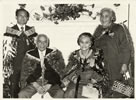Hōne Taiapa
The dramatic shift of many Māori from rural communities to the cities after the Second World War produced two major responses from would-be carvers. Some followed the traditional path exemplified by Hōne Taiapa, younger brother of carver Pine Taiapa, who, as head tutor at the Māori Arts and Crafts Institute, strongly resisted deviation from the ‘classical’ model. He emphasised the ‘craft’ of carving over its esoteric values.
Fine arts schools
Other trainees attended mainstream art schools or teachers’ training colleges, where they could specialise in fine arts in their third year. They were confronted by the widely held belief that Māori art had died with their ancestors. Experts such as the director of the National Art Gallery claimed, ‘No Maori artist of stature has yet arrived. The process of integration has isolated the Maori of today from the living meaning of the arts of his forefathers and his culture must from now on be one with his European neighbour.’1
Māori artists such as Arnold Manaaki Wilson (of Ngāi Tūhoe), who trained at the Elam School of Fine Arts, believed that ‘reviving so-called Maori arts is a dead loss … all they’re getting is a template of what was done before 1840, or worse, a template of the template that was created by the Ngata revival.’2
Urban marae
By the 1970s a large proportion of the Māori population had moved into the cities, and many campaigned for the construction of new marae as part of the urban landscape. A newly built whare whakairo (carved house) such as Hoani Waititi marae in Te Atatū, in Auckland, became symbolic of new life in Māori culture.
Cliff Whiting
Cliff Whiting (of Te Whānau-ā-Apanui) was encouraged to explore the art of whakairo by his relative, the renowned traditionally trained carver Pine Taiapa. Whiting led the restoration and rebuilding of historic wharenui and other marae buildings, and new urban marae. He supervised the carving of Te Kūpenga o te Matauranga at Palmerston North Teachers’ College, which became the first meeting house on a teachers’ college campus when it opened in 1979.
Maru Kaitatea, Kaikōura
Whiting was one of many prominent artists, Māori and Pākehā, who contributed to the wharenui (meeting house) Maru Kaitatea at Takahanga marae in Kaikōura which opened in 2001. The local iwi, Ngāti Kurī, recognised that since the early 1880s, many of their people had intermarried with Europeans. ‘Everyone worked together in a very deliberate way to integrate that inclusiveness into the whole marae statement. It was the first marae to do that.’3
Te Hono ki Hawaiki, Wellington
Te Hono ki Hawaiki, the meeting house at Rongomaraeroa, the marae at the Museum of New Zealand Te Papa Tongarewa, created intense discussion when it opened in 1997. To preserve increasingly scarce native timbers, and to employ the qualities of new materials, Cliff Whiting chose MDF (fibreboard) panels for the marae carvings, which were painted in vibrant pastel colours. The panels in the front of the wharenui represent Māori stories and traditions, while those at the rear stand for the various non-Māori who have made New Zealand their home.
New waka taua
At the same time as the revival of carving meeting houses, there was a renaissance of canoe building. The waka taua (carved canoe) is an important symbol of a tribe’s mana. Tainui leader Te Puea Hērangi, moved by her childhood memories of seeing King Mahuta’s waka Tāheretikitiki on the Waikato River, mobilised her tribe under carver Piri Poutapu to build carved waka that would represent the legendary great fleet that brought Māori to New Zealand.
A full fleet of seven waka was originally planned to take part in the 1940 commemoration of the centenary of the Treaty of Waitangi. Eventually, however, only two new canoes (Aotea and Tākitimu, which was later renamed) were built and a third, Te Winika, was restored. Another waka was built in Kerikeri under Piri Poutapu and Pita Hepera and named Ngātokimatawhaorua. Traditional canoe building flourished again with the sesquicentennial (150th anniversary) of the Treaty of Waitangi in 1990, when a flotilla of 23 ceremonial waka was assembled.








